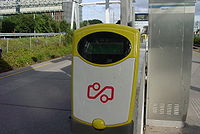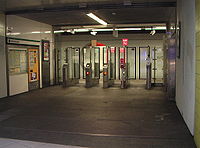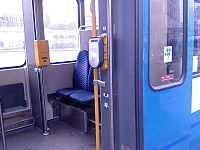
OV-chipkaart
Encyclopedia

Contactless smart card
A contactless smart card is any pocket-sized card with embedded integrated circuits that can process and store data, and communicate with a terminal via radio waves. There are two broad categories of contactless smart cards. Memory cards contain non-volatile memory storage components, and perhaps...
system which is in the process of being introduced on all public transport
Public transport
Public transport is a shared passenger transportation service which is available for use by the general public, as distinct from modes such as taxicab, car pooling or hired buses which are not shared by strangers without private arrangement.Public transport modes include buses, trolleybuses, trams...
in the Netherlands
Netherlands
The Netherlands is a constituent country of the Kingdom of the Netherlands, located mainly in North-West Europe and with several islands in the Caribbean. Mainland Netherlands borders the North Sea to the north and west, Belgium to the south, and Germany to the east, and shares maritime borders...
, including train
Train
A train is a connected series of vehicles for rail transport that move along a track to transport cargo or passengers from one place to another place. The track usually consists of two rails, but might also be a monorail or maglev guideway.Propulsion for the train is provided by a separate...
, metro
Rapid transit
A rapid transit, underground, subway, elevated railway, metro or metropolitan railway system is an electric passenger railway in an urban area with a high capacity and frequency, and grade separation from other traffic. Rapid transit systems are typically located either in underground tunnels or on...
, tram
Tram
A tram is a passenger rail vehicle which runs on tracks along public urban streets and also sometimes on separate rights of way. It may also run between cities and/or towns , and/or partially grade separated even in the cities...
and bus
Bus
A bus is a road vehicle designed to carry passengers. Buses can have a capacity as high as 300 passengers. The most common type of bus is the single-decker bus, with larger loads carried by double-decker buses and articulated buses, and smaller loads carried by midibuses and minibuses; coaches are...
. It allows the combination of card integration (the same card is used for multiple transport companies) and price differentiation (by company, time of day, day of the week, etc.), and is intended to reduce fare dodging. The OV Chip Card replaced the strippenkaart completely on 3 November 2011.
The full name in Dutch
Dutch language
Dutch is a West Germanic language and the native language of the majority of the population of the Netherlands, Belgium, and Suriname, the three member states of the Dutch Language Union. Most speakers live in the European Union, where it is a first language for about 23 million and a second...
is Openbaarvervoerchipkaart (public transport
Public transport
Public transport is a shared passenger transportation service which is available for use by the general public, as distinct from modes such as taxicab, car pooling or hired buses which are not shared by strangers without private arrangement.Public transport modes include buses, trolleybuses, trams...
chip card
Smart card
A smart card, chip card, or integrated circuit card , is any pocket-sized card with embedded integrated circuits. A smart card or microprocessor cards contain volatile memory and microprocessor components. The card is made of plastic, generally polyvinyl chloride, but sometimes acrylonitrile...
).
The OV-chipkaart is a cooperative initiative of five large public-transport operators: NS
Nederlandse Spoorwegen
Nederlandse Spoorwegen , or NS, is the principal passenger railway operator in the Netherlands.Its trains operate over the tracks of the Dutch national railinfrastructure, operated by ProRail, which was split off from NS in 2003...
(railways), Connexxion
Connexxion
Connexxion is the largest public transport bus company in the Netherlands, operating in the west, middle, east and far northern part of the country. It was formed in 1999 as result of a fusion between the public transport companies NZH, ZWN, Midnet and Oostnet. Its name is a mutation of the French...
(buses), RET
Rotterdamse Elektrische Tram
Rotterdamse Elektrische Tram is the main public transport operator in Rotterdam, Netherlands. It currently operates 28 bus lines, 9 tram lines and five metro/light rail lines in Rotterdam and the surrounding municipalities....
(Rotterdam), GVB
Gemeentelijk Vervoerbedrijf
The Gemeentelijk Vervoerbedrijf is the municipal transport company of Amsterdam. As of 2007, the GVB is an independent corporation wholly owned by the city of Amsterdam.-History:...
(Amsterdam), and HTM
HTM Personenvervoer
HTM Personenvervoer NV is a public transport company in the Netherlands operating trams, lightrail and buses in The Hague, Rijswijk, Leidschendam-Voorburg, Delft, Zoetermeer, Wateringen and Nootdorp, the so-called Conurbation Haaglanden...
(The Hague). These five companies established the joint venture
Joint venture
A joint venture is a business agreement in which parties agree to develop, for a finite time, a new entity and new assets by contributing equity. They exercise control over the enterprise and consequently share revenues, expenses and assets...
Trans Link Systems (TLS) to implement the OV-chipkaart. However, all other public transport companies will eventually have to implement the system as well.
In April 2007, the OV-chipkaart received an award in the Transportation category of the Computerworld Honors Program Laureate.
For public transport other than trains, the OV-chipkaart has been the only system valid in the Rotterdam
Rotterdam
Rotterdam is the second-largest city in the Netherlands and one of the largest ports in the world. Starting as a dam on the Rotte river, Rotterdam has grown into a major international commercial centre...
and Amsterdam
Amsterdam
Amsterdam is the largest city and the capital of the Netherlands. The current position of Amsterdam as capital city of the Kingdom of the Netherlands is governed by the constitution of August 24, 1815 and its successors. Amsterdam has a population of 783,364 within city limits, an urban population...
regions since mid-2010, and in most of the rest of the country since 7 July 2011. It will also eventually replace paper rail tickets. For rail journeys involving multiple operators, paper tickets remain cheaper, but there are rail passes for free or discounted off-peak travel which are only available using the OV-chipkaart.
Types of cards

Disposable OV-chipkaart
The disposable OV-chipkaart is made of stiff paper and thrown away after use. It can only be used for travel products and does not feature an electronic purse. It is intended for people who rarely use public transport in the Netherlands, and tourists. It is available for a range of fares, from a short single journey to a three-day pass, and is considerably more expensive than the permanent cards.Anonymous OV-chipkaart
The anonymous OV-chipkaart is a permanent card for people who travel more frequently, but who are not entitled to any discounts. It is reusable and features an electronic purse. It is transferable, and therefore cannot be used for discounted travel, or for monthly or annual season tickets. However, the anonymous card can contain multiple products simultaneously.Personal OV-chipkaart
The personal OV-chipkaart is useful for anyone entitled to travel with a discount (for example children aged 4–11, students, senior citizens and holders of discount cards). It is also the only type that can hold a monthly or annual season ticket. The personal card is non-transferable and features the holder's photograph and date of birth. It includes an electronic purse. In addition, it can be set to top its balance up automatically when it drops below 5 euros. The personal card is the only one which can be blocked if it is lost or stolen. The personal OV-chipkaart is currently only available to Dutch bank-account holders.Travelling with the OV-chipkaart


Paying for a trip
There are two ways to pay for travel using the OV-chipkaart:Travellers can buy a travel product, for example a one-day pass for an entire city or a monthly season ticket for a certain route. When they check out after the trip (see next section), the system will recognise that a certain product has been used and, if necessary, deactivate it.
The other option is to use money from the electronic purse on the OV-chipkaart. At check-in, the system charges a checking-in fee, ranging from 4 to 20 euro, depending on the type of transport and the discount. This in then refunded when the traveller checks out, minus the fare for the trip actually made. If a user fails to check out the difference, which is higher than the fares for most of the possible journeys, is not refunded. If all card readers are out of order, the traveller can claim the checking-in fee back from the travel authority. If a traveller fails to check out too many times the card is blocked and cannot be used again, even if there is a valid product on it.
During a trip, travel staff can check cards using a mobile reader. One must travel away from the point where one checked in.
Checking in and out: train or metro
For journeys by train or metro, the traveller checks in by holding the OV-chipkaart up to a reader on reaching the platform. The checking-in fee is debited. When leaving a station, the passenger checks out by holding the card up to the reader and the checking-in fee is refunded, minus the fare for the journey actually made (where appropriate).There are two types of card-reader systems on train and metro stations: free-standing card readers, and card readers integrated into ticket gates. To prevent fare dodging, gates are used wherever possible, for example in underground or elevated stations, where travellers cannot access the platforms without going through the gates. Stations at ground level generally have free-standing card readers. Gates were considered too dangerous at ground-level stations, since they would encourage fare-dodgers to bypass them and access the platforms by walking on the rails. However, this still happens, for example at Rotterdam Alexander.
Checking in and out: tram or bus
When travelling by tram or bus, travellers check in and out when entering or leaving the vehicle, using card readers located by the doors. Passengers usually board buses and trams by the door nearest to the driver or conductor, who keeps an eye on them checking in. The driver or conductor cannot so easily monitor passengers disembarking. A passenger who fails to check out on exit will pay too much for the journey, since the excess portion of the check-in fee is not refunded. In addition, passengers can dodge part of their fare by checking out long before the end of their journey. For this reason, random fare checks will continue to operate.Technology
The OV-chipkaart is based on PhilipsPhilips
Koninklijke Philips Electronics N.V. , more commonly known as Philips, is a multinational Dutch electronics company....
(currently NXP Semiconductors) Mifare
MIFARE
MIFARE is the NXP Semiconductors-owned trademark of a series of chips widely used in contactless smart cards and proximity cards. According to the producers, billions of smart card chips and many millions of reader modules have been sold...
technology. The anonymous and personal cards are Mifare Classic 4K cards with about 4 kilobytes of storage. They are read/write protected by keys known only to the vendors. The disposable passes are cheaper Mifare Ultralight cards that do not employ any encryption or keys, and can be read by anyone. The Mifare encryption algorithm (known as Crypto-1
Crypto-1
Crypto-1 is a proprietary encryption algorithm created by NXP Semiconductors specifically for Mifare RFID tags, including Oyster card, CharlieCard and OV-chipkaart.Recent cryptographic research...
) is believed to have been cracked. Even so, the transport corporations are continuing with the introduction of the OV-chipkaart, since the security of the system does not rely on the encryption of the tickets. Once the complete security system is in place, the authorities claim they will be able to detect fraudulent cards (cloned cards, or changed content, e.g. a not-warranted e-purse reload) and blacklist suspect cards.
However recent developments have shown that it is now relatively easy to hack the cards. At first, an extensive knowledge of the Linux
Linux
Linux is a Unix-like computer operating system assembled under the model of free and open source software development and distribution. The defining component of any Linux system is the Linux kernel, an operating system kernel first released October 5, 1991 by Linus Torvalds...
-based Operating System was required in order to read or alter data on the OV-Chipkaart. Recently, however, programs have surfaced for Windows that only require a Mifare card reader to add credit to the card. And it has also been proved that cards can be hacked in ways invisible to Trans Link Systems. This is done by checking the card in at home with the hacking software, which in turn means that TLS will not see that the card is being used. The current card-checking technology also fails to reveal fraudulent check-ins on board.
Even though the release of these programs mean that anyone with the program and a card reader/writer can travel for free without being caught, the Ministry of Infrastructure and the Environment
Ministry of Infrastructure and the Environment (Netherlands)
The Ministry of Infrastructure and the Environment is a Dutch ministry created in 2010 by the Rutte Cabinet, and is a merger of the former Ministry of Transport, Public Works and Water Management and Ministry of Housing, Spatial Planning and the Environment. The minister is Melanie Schultz van...
is continuing the roll-out of the OV-Chipkaart, but has announced that TLS will start producing cards with the more fraud-resistant SmartMX chip. However, it may take up to six years for the new cards to replace the old ones.
The technology is not faultless. Upon checking out, the card readers display the amount deducted and the remaining balance. It is not uncommon for the wrong amount to be deducted: a sample of journeys in 2011 which bear a €1.09 fare has resulted in changes of €0.77, €1.53 and €2.37. Passengers who notice these errors can claim a refund via the relevant operator's website, quoting a Dutch bank account number. However experience shows that operators do not necessarily refund overcharges.
Rollout
The OV-chipkaart was first introduced in the Rotterdam metroRotterdam Metro
The Rotterdam Metro is a rapid transit system operated in Rotterdam and surrounding municipalities by RET. The first line, called Noord - Zuidlijn opened in 1968 and ran from Centraal Station to Zuidplein, crossing the river Nieuwe Maas in a tunnel. It was the first metro system to open in the...
, in April 2005. In 2006, the programme was expanded to include all Amsterdam metro
Amsterdam Metro
The Amsterdam Metro is a mixed rapid transit and light rail system in Amsterdam, and its surrounding municipalities Amstelveen, Diemen, and Ouder-Amstel in the Netherlands. The network is owned by the city of Amsterdam and operated by the Gemeentelijk Vervoerbedrijf, the company that also operates...
and rapid-tram (Sneltram) lines (50, 51, 53, 54). All trams and buses in Rotterdam accepted the OV-chipkaart from June 2007, and in November 2008 this was extended to all trams and buses in Amsterdam.
Until 29 January 2009, traditional fare-collection systems were still in place everywhere, alongside the OV-chipkaart. Thereafter, the strippenkaart ceased to be valid in the Rotterdam metro, leaving the OV-chipkaart as the only option. The Amsterdam metro withdrew the strippenkaart on 27 August 2009. On 11 February 2010, the Rotterdam region withdrew the strippenkaart completely. The Amsterdam region followed suit on 3 June 2010. The province of South Holland
South Holland
South Holland is a province situated on the North Sea in the western part of the Netherlands. The provincial capital is The Hague and its largest city is Rotterdam.South Holland is one of the most densely populated and industrialised areas in the world...
(including The Hague) withdrew the strippenkaart on 19 May 2011. The strippenkaart ceased to be valid anywhere on 3 November 2011.
At the time of writing (August 2011), the OV-chipkaart can be used in the whole of the Netherlands, except for some of the Frisian islands and some regional rail operators.
For the national rail carrier NS, the system has been operational for full-fare travel since October 2009, and for discounted fares since December 2009. There are plans to introduce the OV-chipkaart for other forms of travel as well (e.g. monthly or annual passes).

